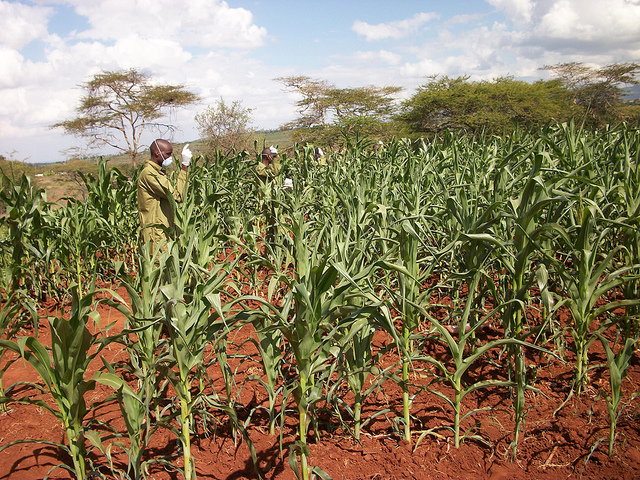Overview
Researchers
Vivian Hoffmann
Research Fellow at the International Food Policy Research Institute (IFPRI)
Erwin Bulte
Professor of Development Economics at Wageningen University
Janneke Pieters
Assistant Professor in the Development Economics Group at Wageningen University, the Netherlands
Alexander Saak
Research Fellow with the Market, Trade and Institutions Division at Internatioanl Food Policy Research Institute (IFPRI)
- Country
- Kenya
- Timeline
- 04/01/2016 - 09/30/2017
- Constraints
- Information, Input and Output Markets
- Technology Category
- Contracts, Crop Quality Measure, Extension, Inputs, Outputs

Aflasafe application. Photo credit: IITA via Flickr
Policy Issue
Foodborne pathogens and toxins exact a significant health toll in developing countries[1], particularly among the poorest[2]. Aflatoxin is a common fungal toxin in maize and groundnut that is known to cause cancer and liver damage, and is suspected of inhibiting immune system function and contributing to childhood stunting[3]. Much of African produce is affected by aflatoxin, diminishing producers’ access to potentially more lucrative high-value domestic and export markets[4]. In particular, Kenya’s Meru County is known as a global aflatoxin hotspot and is the site of this study. Kenya is one of only two African countries in which an aflatoxin biocontrol product has been licensed for general use, and the country in which the most severe health consequences have been documented.
The presence of fungal toxins disqualifies many smallholder maize farmers in Kenya and other developing countries from successfully meeting food safety standards required by major processors, limiting their options for sale. Farmers are generally able to meet other quality criteria demanded by these markets through careful post-harvest practices and sorting, but aflatoxin may be present without any visible sign of contamination. Although there are effective tools to combat aflatoxin available in Kenya, the biocontrol product Aflasafe KE01 and mobile maize dryers, there is very limited adoption by farmers.
Researchers will develop and rigorously evaluate business models to support the scale-up of Aflasafe and mobile dryers in Kenya. In addition to producing generalizable knowledge, this research will inform efforts by the Government of Kenya to scale up aflatoxin control options through the private sector. There are plans to scale up Aflasafe in 11 countries in the region over the next 5 years, and study findings will have immediate applicability to smallholders in these countries.
Details of the evaluation
Technologies to improve the safety of farm produce, including biocontrol products such as Aflasafe, face barriers to adoption by smallholders:
- Food safety is a hidden trait. Although observation of many contaminants is possible using rapid tests, these tests are costly relative to the value of farm produce.
- Crop output markets are inefficient, characterized by multiple intermediaries that can benefit when selling crops to buyers with incomplete information about crop quality. These “informational asymmetries” can prevent pass-through of consumer incentives for food safety to producers.[5]
This RCT will identify farmers’ approaches to managing food safety risk. Researchers will evaluate the adoption of two ex ante technologies (Aflasafe and mobile dryers) for preventing toxic fungal contamination, and an ex post testing technology (rapid testing), by smallholder farmers in Kenya, in situations where smallholders’ access to high-value markets are facilitated, and where they are not.
All farmer groups in the study will have access to Aflasafe and mobile dryers. Their access to output markets and individual aflatoxin tests will depend on their random assignment to one of four treatments:
| Individual Aflatoxin Testing | No Individual Aflatoxin Testing | |
| Independent Marketing | 25% | 25% |
| Market Linkage | 25% | 25% |
- INDEPENDENT MARKETING: Farmers are provided with information about aflatoxin and an opportunity to purchase Aflasafe KE01 and to use a mobile maize drying service. No information regarding buyers willing to pay for aflatoxin-safe produce is provided.
- MARKET LINKAGE: Farmers are provided with the same information and opportunity to purchase Aflasafe and use dryers as above. In addition, they are presented with a letter of intent from a prospective buyer stating an offer price (indexed to the current open air market price) conditional on safety and other quality parameters. An aggregator connected to this buyer will test the maize for aflatoxin, and maize that conforms to the standard will be purchased by the aggregator.
- INDIVIDUAL AFLATOXIN TESTING: Randomly selected farmer groups from both Independent Marketing and Market Linkage treatments will be able to pay for individual level aflatoxin tests, administered by study personnel. The cost of testing will reflect the expected retail cost of low-cost rapid aflatoxin tests under development. Farmers could then sell tested maize to an aggregator (through an intervention-facilitated or independent connection) or retain it for household consumption.
For ethical reasons, any maize that is above the median level currently available in the local market will be purchased at the current market rate and directed to the animal feed market, decontaminated, or destroyed.
Adoption of Aflasafe and dryers will be compared across farmer groups randomly assigned to receive a food safety conditional purchase commitment from a formal sector buyer (“Market Linkage”), and those left to find buyers independently (“Independent Marketing”). The impact on Aflasafe and dryer adoption of access to low-cost testing for the contaminant will also be tested through random assignment of farmer groups to receive the opportunity to purchase such tests.
Results and Policy Lessons
Project ongoing, results forthcoming.
[1] (WHO, 2015)
[2] (Shephard, 2014; Moser and Hoffmann, 2015)
[3] (Gong et al., 2004; Strosnider et al., 2006; Turner et al., 2007; Hoffmann et al., 2015)
[4] (Munasib and Roy, 2011)
[5] (Fafchamps et al., 2008)